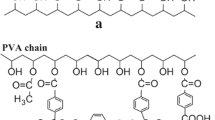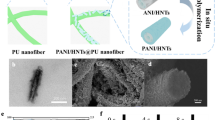Abstract
Amphiphilic comb-like polysiloxane (ACPS) containing polyether side chains was used as the modification reagent in the preparation of hydrophilic porous poly (vinylidene fluoride) (PVDF) membranes via a phase inversion process. The effects of ACPS on morphology, crystallinity, mechanical properties, reservation of ACPS in the phase inversion process, chemical structure, hydrophilicity and filterability performance of porous PVDF membranes were discussed. It was found that the addition of ACPS would result in the delayed demixing which yields “sponge-like” sublayers and longer crystallization time during the membrane formation process. It was revealed that O/F ratios of the bulk membrane were almost the same as those of the corresponding casting solutions which obviously indicated the high reservation of ACPS in the membrane formation process. The fact that the O/F ratios in the membrane surface layers were much higher than those in the bulk membrane proved the enrichment of ACPS on the surface. The filterability experiments and water contact angle testing proved the hydrophilicity of the blend membranes. Through a schematic model, the mechanism relating the membrane structure and performance was interpreted. From the observed results, it can be concluded that ACPS acts as a potential candidate material for preparing PVDF membranes with extraordinary hydrophilicity and filterability.
Similar content being viewed by others
References
Ochoa N A, Masuelli M, Marchese J. Effect of hydrophilicity on fouling of an emulsified oil wastewater with PVDF/PMMA membranes. J Membr Sci, 2003, 226(1–2): 203–211
Liu F, Zhu B K, Xu Y Y. Improving the hydrophilicity of poly (vinylidene fluoride) porous membranes by electron beam initiated surface grafting of AA/SSS binary monomers. Appl Surf Sci, 2006, 253: 2096–2101
Ying L, Kang E T, Neoh K G. Covalent immobilization of glucose oxidase on microporous membranes prepared from poly(vinylidene fluoride) with grafted poly(acrylic acid) side chains J Membr Sci, 2002, 208: 361–374
Park YW, Inagaki N. Surface modification of poly(vinylidene fluoride) film by remote Ar, H2, and O2 plasmas. Polymer, 2003, 44: 1569–1575
Clochard MC, Bègue J, Lafon A, Caldemaison D, Bittencourt C, Pireaux J J, Betz N. Tailoring bulk and surface grafting of poly(acrylic acid) in electron-irradiated PVDF. Polymer, 2004, 45: 8683–8694
Klee D, Ademovic Z, Bosserhoff A, Hoecker H, Maziolis G, Erli H J. Surface modification of poly(vinylidenefluoride) to improve the osteoblast adhesion. Biomaterials, 2003, 24: 3663–3670
Han S, Choi W K, Yoon K H, Koh S K. Surface reaction on polyvinylidenefluoride (PVDF) irradiated by low energy ion beam in reactive gas environment. J Appl Polym Sci, 1999, 72: 41–47
Enrica F, Johannes C J, Alessandra C, Efrem C, Enrico D. Effect of additives in the casting solution on the formation of PVDF membranes. Desalination, 2006, 192: 190–197
Wang Y Q, Wang T, Su Y L, Peng F B, Wu H, Jiang Z Y. Remarkable Reduction of Irreversible Fouling and Improvement of the Permeation Properties of Poly(ether sulfone) Ultrafiltration Membranes by Blending with Pluronic F127. Langmuir, 2005, 21: 11856–11862
Yeow ML, Liu Y, Li K. Preparation of porous PVDF hollow fiber membrane via a phase inversion method using lithium perchlorate (LiClO4) as an additive. J Membr Sci, 2005, 258: 16–22
LU Y, CHEN H L, LI B G. Influence of Additives on Phase Separation Process of PVDF Solution and Membrane Morphology. Acta Polymerica Sinica, 2002, 5: 656–661 (in Chinese)
Lu X F, Bian X K. Surface modification of ultrafiltration membrane and its application. Membr Sci & Technol, 2003, 23: 97–115 (in Chinese)
Chen H, Belfort G. Surface modification of poly(ether sulfone) ultrafiltration membranes by low-temperature plasma-induced graft polymerization. J Appl Polym Sci, 1999, 72: 1699–1711
Pieracci J, Crivello J V, Belfort G. Photochemical modification of 10 kDa polyethersulfone ultrafiltration membranes for reduction of biofouling. J Membr Sci, 1999, 156: 223–240
Nunes S P, Sforca M L, Peinemann K V. Dense hydrophilic composite membranes for ultrafiltration. J Membr Sci, 1995, 106: 49–56
LI B, CHEN W G, WANG X G, ZHOU Q X. PNIPAAm-Grafted Layers on Polypropylene Films II. Surface Properties and Temperature Sensitivity Study. Acta Polymerica Sinica, 2003, 1: 7–12 (in Chinese)
Kelly S T, Zydney A L. Mechanisms for BSA fouling during microfiltration. J Membr Sci, 1995, 107: 115–127
Kim J H, Lee K H. Effect of PEG additive on membrane formation by phase inversion. J Appl Polym Sci, 1998, 138: 153–163
Kim I C, Lee K H. Effect of poly(ethylene glycol) 200 on the formation of a polyetherimide asymmetric membrane and its performance in aqueous solvent mixture permeation. J Membr Sci, 2004, 230: 183–188
Chen N P, Hong L. Surface phase morphology and composition of the casting films of PVDF-PVP blend. Polymer, 2002, 43: 1429–1436
Qin J J, Wong F S, Li Y, Liu Y T. A high flux ultrafiltration membrane spun from PSU/PVP (K90)/DMF/1,2-propanediol. J Membr Sci, 2003, 211: 139–147
Park J Y, Acar M H, Ariya A, William K, Mayes A M. Polysulfone-graft-poly(ethylene glycol) graft copolymers for surface modification of polysulfone membranes. Biomaterials, 2006, 27: 856–865
Ma X L, Su Y L, Sun Q, Wang Y Q, Jiang Z Y. Preparation of protein-adsorption-resistant polyethersulfone ultrafiltration membranes through surface segregation of amphiphilic comb copolymer. J Membr Sci, 2007, 292: 116–124
Hester J F, Banerjee P, Won Y Y, Akthakul A, Acar M H, Mayes A M. ATRP of Amphiphilic Graft Copolymers Based on PVDF and Their Use as Membrane Additives. Macromolecules, 2002, 35: 7652–7661
Hester J F, Mayes A M. Design and performance of foul-resistant poly(vinylidene fluoride) membranes prepared in a single-step by surface segregation. J Membr Sci, 2002, 202: 119–135
Irvine D J, Mayes A M. Nanoscale Clustering of RGD peptides at surfaces using comb polymers. 1. synthesis and characterization of comb thin films. Biomacromolecules, 2001, 2: 85–94
Hester J F, Banerjee P, Mayes A M. Preparation of protein-resistant surfaces on poly(vinylidene fluoride) membranes via surface segregation. Macromolecules, 1999, 32: 1643–1650
Legrow G E, Buese M A. Alkylmethylsiloxane dimethylsiloxane polyalkylene oxide copolymers. Eur Patent, EP. 1149872A2. 2001-10-31
Lovinger A J. Annealing of Poly (vinylidene fluoride) and formation of a fifth phase. Macromolecules, 1982, 15: 40–44
Zheng Q Z, Wang P, Yang Y N. Rheological and thermodynamic variation in polysulfone solution by PEG introduction and its effect on kinetics of membrane formation via phase-inversion process. J Membr Sci, 2006, 279: 230–237
Nardin C, Meier W. Hybrid materials from amphiphilic block copolymers and membrane proteins. Molecular Biotechnology, 2002, 90: 17–26
Callewaert M, Gohy J F, Dupont-Gillain C C, Laurence B P and Rouxhet P G. Surface morphology and wetting properties of surfaces coated with an amphiphilic diblock copolymer. Surf Sci, 2005, 575: 125–135
Yuan J Y, Wei G Y, Wang Y M, Pan G Y. Syntheses and Characterization of ABA Type Amphiphilic Block Copolymer. Acta Polymerica Sinica, 2001, 5: 625–628 (in Chinese)
Gao B J, Yang Y F, Jiu H F, Ge Z. Synthesis of Water-Solution Amphiphilic Acrylamide-Styrene Block Polymer Using Microemulsion Method. Acta Polymerica Sinica, 2001, 5: 608–612 (in Chinese)
Author information
Authors and Affiliations
Corresponding author
Additional information
__________
Translated from Acta Polymerica Sinica, 2007, 12: 1168–1175
About this article
Cite this article
Qian, Y., Wang, J., Zhu, B. et al. Modification effects of amphiphilic comb-like polysiloxane containing polyether side chains on the PVDF membranes prepared via phase inversion process. Front. Chem. China 3, 432–439 (2008). https://doi.org/10.1007/s11458-008-0078-0
Published:
Issue Date:
DOI: https://doi.org/10.1007/s11458-008-0078-0




